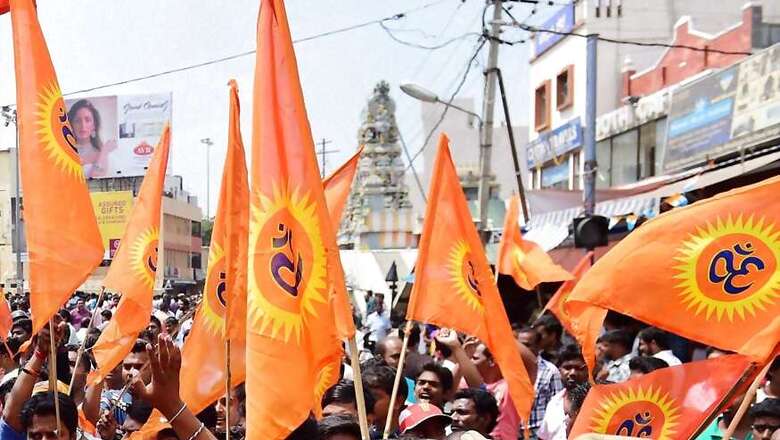
views
Kochi: Shabbirpur, Una, and now Bhima-Koregaon. Violence against the Dalit community has often the fringe Hindutva brigade at one end, and the media is quick to pin the blame on the “Brahminical RSS”. There could be vested interests at play here who want to paint the Sangh as a “Maharashtrian Brahmin” outfit that has a patronizing attitude towards OBCs and Dalits, but the RSS is anything but a monolith.
A case in point is Kerala, a state that Hindutva trolls often paint as the land of “beef-eaters” and “love jihad”.
India’s most literate state that has many firsts to its credit also boasts of a mighty RSS apparatus that has OBCs and Dalits at its core, and Brahmins almost as a footnote. And the credit – to the chagrin of the Hindutva trolls – often goes to the largely egalitarian culture of Kerala society. Once notorious as a “madhouse of caste” – as Swami Vivekananda described Kerala – the state steadily went on the path of inclusion thanks to sweeping reform movements launched by the likes of Sree Narayana Guru and Ayyankaali, and perfected by, well, the “Godless” communists.
And then there is this little thing that the RSS was established in Kerala in 1942 by Dattopant Thengadi, the legendary RSS leader who went on to form the Sangh’s trade unions such as Bhartiya Mazdoor Sangh and Bhartiya Kisan Sangh. And there is no shortage of communists who claim Thengadi was in turn influenced by his Kerala stint that he went on to found organisations like BMS and BKS that is modelled on Leftist trade unions.
“Both Thengadi and Shankar Shastri (also deputed from Nagpur to set up shakhas) wanted to steer clear of the Brahminical set up of the RSS. They wanted an RSS in Kerala that is closer to the unique sociological tapestry of the state,” says a former Pracharak who doesn’t want to be named. Kerala might still be a steep mountain for BJP to climb, but the state boasts of one of the largest number of RSS shakhas in India. And the prime reason for that is that the Sangh built up in the state had Kerala’s social DNA all over it. The same cannot be said of Kerala’s BJP.
The first swayamsevak who went to the officer’s training camp (OTC) of the RSS from Kerala was Ambali Karunakaran, an OBC. The first batch of Pracharaks also had many Dalit faces and they campaigned and started shakhas in the state competing with the Communists taluk by taluk.
Krishnan Kutty, a senior Pracharak and Prantheeya Karya Kari Sadasya (state committee member) of RSS, says he never faced any discrimination within Sangh because of being a Dalit. “In the last 41 years, the first time I was made conscious of my caste was when you asked about this,” Kutty tells this writer. “It was never an issue when I stayed with the so-called high caste families, so it is totally irrelevant for me,” he says.
Kerala has a long history of social reformation much before the dawn of Communist movement. The reformist movement that swept various sects of Hinduism – from Brahmins led by VT Bhattithirpad to Dalits led by Ayyankaali – made a significant impact on the progressive youths cutting across caste line all throughout the state.
The Communist Party of India reaped the major chunk of the dividend out of this social reformation. The Kerala state committee of the (undivided) CPI started in 1939 and in 17 years they succeeded in forming the government in the maiden assembly election for the newly formed Kerala state.
That the Left government led by EMS Namboodiripad (a Brahmin) was dismissed – the first time Article 356 was activated in Independent India – by none other than Jawaharlal Nehru thanks to an agitation led by an assorted group of upper caste Nairs, the Catholic Church and the Congress party is another interesting nugget from Kerala history.
While the Communist movement tried to improve the social and financial status of the downtrodden, the Sangh aimed at spiritual enhancement. Today, the CPM government led by Pinarayi Vijayan has taken the credit for allowing non-Brahmin priests in Devaswom Board-run temples, but the seeds were first sown by the Sangh.
The RSS had started the first all-caste training centre to teach Tantra Vidya (the ritual training for temple priests) named Tantra Vidya Peetham. It was initiated by P Madhavan, a Pracharak who hailed from the upper caste Nair community along with Parur Sreedharan Tantri, an OBC scholar of temple rituals.
And it was anything but an easy task. For starters, there were 21 Vedic families in Kerala (families with the “authority” over temple rituals). Although Sree Narayana Guru started a centre with the same goal, it ended up being an institute mostly for the Ezhava community. P Madhavan and Sreedharan Tantri made several deliberations with these families and other scholars. There were heated debates regarding the Braminical right to perform pujas. But Sreedharan Tantri quashed all those claims by his deft interpretation of the Vedas and other religious texts.
Numerous non-Brahmin priests graduated from this institution. Parur Rakesh Tantri is the first non-Brahmin Tantri to be recognized by the Devaswom Board, following a high court verdict. These days Rakesh looks after a number of temples in the state.
The Vishala Hindu Sammelan (Grand Hindu Conclave) organised by the RSS in 1982 in Kochi started off with a Sudarshana Homa led by Sreedharan Tantri. He was assisted by a member of the Sooryakalady Mana, one of the most orthodox Brahmin families of the state.
This incident snowballed into a political issue in the 1987 state assembly elections. Incidentally, BJP had its best vote share yet in this poll, until it bettered it in 2001.
KV Madanan, former all India vice president of Viswa Hindu Parishad (VHP), is a Dalit and started his social life as an RSS karyakartha. “I had stayed in various high priest Brahmin homes in both Kerala and all over India. The womenfolk in those houses serve me food and washed by plates. I believe it would not have been possible if I was not a Sangh karyakartha”, he reminisces. Madanan retired as the Director of Public Instruction (DPI) and the commissioner of state entrance examination, a post nowadays held only by IAS officers.
Madanan is only happy to give credit where it is due. He firmly believes he was accepted by one and all in Kerala thanks to its history of social reform movements. And he has a point to make. “The only way to erode caste inequality is to encourage inter-caste marriages,” he says. The social reformers of yore would agree with him wholeheartedly. Now that’s an agenda that the RSS can adopt, within and without Kerala.
Author is a freelance writer based in Kochi. Views are personal.




















Comments
0 comment